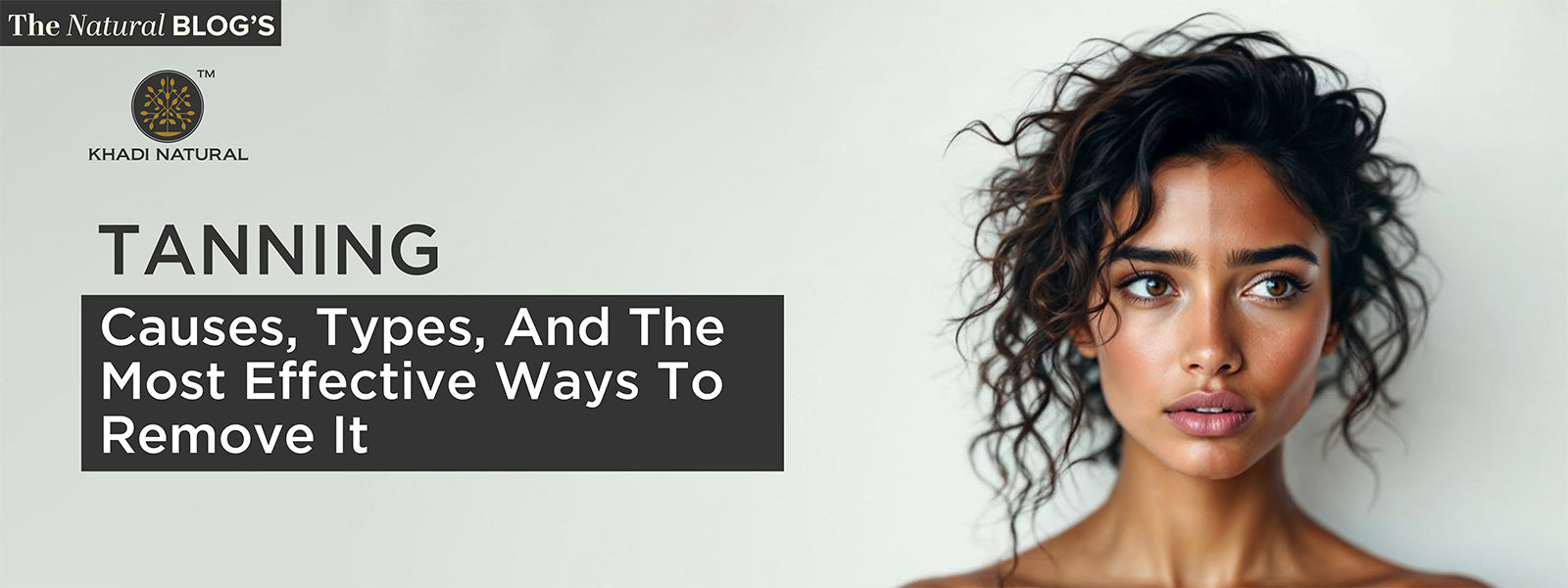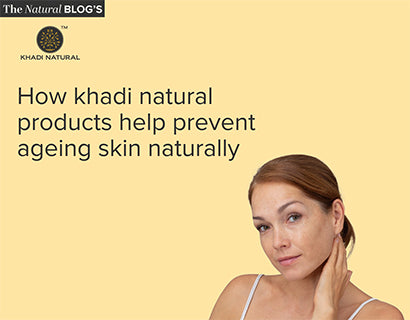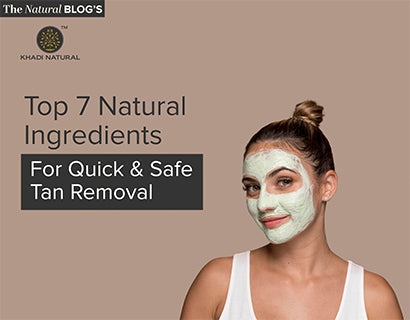
Tanning: Causes, Types, and the Most Effective Ways to Remove It
Sun-kissed skin may sound like a compliment, but in reality, tanning is your skin’s way of signalling,“Help! I’m under attack.” While a light glow might seem harmless, tanning often means your skin is experiencing damage from ultraviolet (UV) rays. If left untreated, it can lead to uneven skin tone, premature ageing, and, in severe cases, long-term harm.
In this blog, we’ll explore why tanning happens, the different types of skin tanning, and the most effective ways to remove it naturally and safely.
Table of Contents
What is Tanning?
Tanning is the process where skin becomes darker due to exposure to ultraviolet (UV) rays from the sun or artificial sources like tanning beds. When UV rays reach the skin, they trigger cells called melanocytes to produce more melanin, the pigment that gives skin its colour.
This extra melanin acts as a natural defence, helping protect deeper skin layers from damage. While some see tanning as a cosmetic change, body tanning is actually a sign of skin damage and can lead to premature ageing, sunburn, and increased risk of skin cancer. Sunscreen, protective clothing, and shade can help prevent tanning and UV-related harm.
What Causes Skin Tanning?
Tanning happens when melanin, the pigment responsible for your skin colour increases in production. This is your body’s natural defence mechanism against UV radiation. When your skin is exposed to the sun (or even artificial tanning lights), UV rays penetrate the epidermis and trigger melanocytes to produce more melanin, creating that darker appearance.
The main reasons for skin tanning include:
-
Direct Sun Exposure – Spending long hours under the sun without sunscreen is the fastest way to get a tan.
-
Artificial UV Sources – Tanning beds and sunlamps can be even more harmful than natural sunlight.
-
Reflected UV Rays – Water, snow, and sand can reflect up to 80% of UV rays, intensifying exposure It is one of the most common causes of tanning on the face.
-
Inconsistent Sun Protection – Skipping sunscreen or using too little leaves skin vulnerable.
Types of Tanning
Not all tans are the same; there are different types of tanning, and understanding the type can help you choose the right treatment.
1. Immediate Pigment Darkening (IPD): This happens within minutes of sun exposure and is usually temporary. It’s caused by oxidation of existing melanin and fades within a day.
2. Delayed Tanning: This develops hours to days after sun exposure and can last for weeks. It’s due to increased melanin production in response to UVB rays.
3. Sunburn Tan: A sign of overexposure, where the skin first turns red, peels, and then appears darker. This is actual skin damage and needs extra care.
4. Chronic Tanning: Repeated sun exposure over months or years can lead to permanent darkening in certain areas, often accompanied by signs of ageing like wrinkles and sunspots.
The Risks of Tanning
While some see a tan as a “healthy glow”, the truth is that there’s no such thing as a safe tan. The damage from UV exposure builds over time, increasing the risk of:
-
Premature Ageing – Fine lines, wrinkles, and sagging skin.
-
Hyperpigmentation – Uneven dark patches.
-
Sunburn & Skin Sensitivity – Short-term redness and irritation.
-
Skin Cancer – Long-term UV damage is a major risk factor for melanoma and other skin cancers.
Most Effective Ways to Remove Tanning
Luckily, skin tanning is not always permanent. Depending on the severity, it can be lightened and even completely removed with the right care.
Here are the most effective tan removal tips:
1. Natural Home Remedies
a. Lemon Juice & Honey – Lemon acts as a natural bleaching agent, while honey soothes the skin.
-
Mix 1 tbsp lemon juice with 1 tbsp honey.
-
Apply for 20 minutes, then rinse with lukewarm water.
b. Cucumber Extract – Cools the skin and helps fade tan.
-
Blend the cucumber and strain the juice.
-
Apply with cotton on tanned areas.
c. Aloe Vera Gel – Heals sunburn and reduces pigmentation.
-
Use pure aloe gel overnight for best results.
d. Gram Flour & Turmeric Pack – A traditional remedy to brighten skin.
-
Mix 2 tbsp gram flour, a pinch of turmeric, and milk or rose water.
-
Apply for 15–20 minutes before rinsing.
2. Exfoliation
Dead skin cells trap excess pigment, making the tan look darker.
-
Use gentle scrubs, such as Khadi Natural Rose, Apricot & Walnut Exfoliating Facial Scrub 2–3 times a week.
-
Avoid harsh exfoliants if your skin is sunburnt.
3. Chemical Peels
Dermatologists use mild acids like glycollic acid or lactic acid to remove the outer layer of skin, revealing fresher, lighter skin underneath. Best for stubborn tans.
4. Laser Treatment
For deep, chronic tanning, laser therapy targets melanin deposits and breaks them down. This is a quick but more expensive option, recommended only for severe cases.
5. Skin-Lightening Creams
Over-the-counter tanning solutions, such as creams with ingredients like niacinamide, kojic acid, or vitamin C, can gradually fade tanning. Always patch-test to avoid irritation.
Tips to Prevent Tanning
As with most skin concerns, prevention is better than cure. Here’s how to avoid tanning in the first place:
-
Apply Sunscreen Daily – Choose sunscreen with SPF 50+ and reapply every 2 hours.
-
Wear Protective Clothing – Wide-brimmed hats, sunglasses, and full sleeves.
-
Seek Shade – Especially between 10 am and 4 pm when UV rays are strongest.
-
Avoid Tanning Beds – They emit harmful UV radiation.
-
Use SPF Even Indoors – UV rays can pass through glass windows.
How Long Does It Take to Remove a Tan?
This depends on the depth of pigmentation and your skin’s natural regeneration cycle.
-
Mild Tan – Fades within 1 – 2 weeks with regular care.
-
Moderate Tan – May 3 – 4 weeks to lighten.
-
Deep Tan – Could take several months and might require professional treatments.
Final Thoughts
Tanning may seem like a cosmetic concern, but it’s actually your skin’s cry for help. Understanding the causes and types of tanning can help you take the right steps to both treat and prevent it. Whether you opt for natural remedies, dermatological treatments, or a mix of both, the key is consistency and sun protection.
Remember: your natural skin tone is beautiful. Instead of chasing temporary bronzed looks that can damage your skin, focus on keeping it healthy, hydrated, and protected.
FAQs
Q. Can a tan be permanent?Ans: In most cases, tans fade as skin naturally renews, but repeated sun exposure can cause long-term pigmentation and uneven skin tone.
Q. How long does it take for a tan to fade naturally?Ans: Mild tans may fade in 1–2 weeks, while deeper tans can take several months without treatment.
Q. Does sunscreen completely prevent tanning?Ans: Sunscreen reduces tanning but doesn’t block UV rays entirely. Using SPF 30+ and reapplying every 2 hours offers the best protection.
Q. Can I remove tanning overnight?Ans: No, safe tan removal takes time. Overnight remedies may lighten the skin slightly, but consistent care is needed for full results.
Q. Which home remedy is best for removing tan?Ans: A mix of lemon juice and honey, aloe vera gel, or gram flour and turmeric paste are popular natural remedies for lightening tans.









